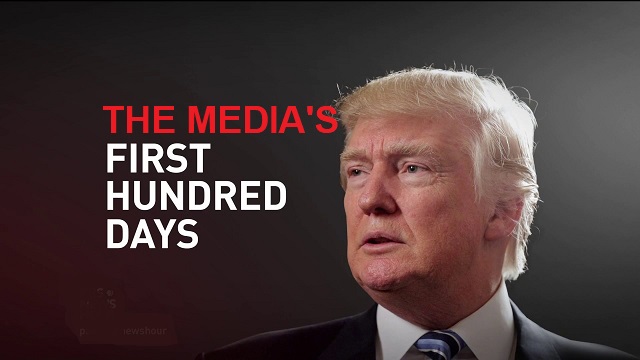Harvard Study: Media coverage of Trump’s first 100 days ‘set a new standard for negativity’
“The press is your enemy. Enemies. Understand that? . . . Because they’re trying to stick the knife right in our groin.” – President Donald J. Trump.
A new report from Harvard Kennedy School’s Shorenstein Center on Media, Politics and Public Policy analyzed news coverage of President Donald Trump’s first 100 days in office. The report is based on an analysis of news reports in the print editions of The New York Times, The Wall Street Journal, and The Washington Post, the main newscasts of CBS, CNN, Fox News, and NBC, and three European news outlets (The UK’s Financial Times and BBC, and Germany’s ARD).
Thomas E. Patterson, Bradlee Professor of Government and the Press, in the Introduction and Methodology section of the report writes:
Trump’s dislike of the press was slow in coming. When he announced his presidential candidacy, journalists embraced him, and he returned the favor. Trump received far more coverage, and far more positive coverage, than did his Republican rivals. Only after he had secured the Republican nomination did the press sharpen its scrutiny and, as his news coverage turned negative, Trump turned on the press.
[ … ]
The media have been fascinated by Trump since the first days of his presidential candidacy. Our studies of 2016 presidential election coverage found that Trump received more news coverage than rival candidates during virtually every week of the campaign. The reason is clear enough. Trump is a journalist’s dream. Reporters are tuned to what’s new and different, better yet if it’s laced with controversy. Trump delivers that type of material by the shovel full. Trump is also good for business. News ratings were slumping until Trump entered the arena. Said one network executive, “[Trump] may not be good for America, but [he’s] damn good for [us].”
Read the full report of President Donald Trump’s first 100 days in office
The report found:
- Although journalists are accused of having a liberal bias, their real bias is a preference for the negative.
- Once upon a time, the “honeymoon” period for a newly inaugurated president included favorable press coverage. That era is now decades in the past. Today’s presidents can expect rough treatment at the hands of the press, and Donald Trump is no exception (see Figure 4 below). Of the past four presidents, only Barack Obama received favorable coverage during his first 100 days, after which the press reverted to form.
- Trump’s coverage during his first 100 days set a new standard for negativity. Of news reports with a clear tone, negative reports outpaced positive ones by 80 percent to 20 percent.
- Trump’s coverage was unsparing. In no week did the coverage drop below 70 percent negative and it reached 90 percent negative at its peak (see Figure 5 below).
- Trump’s attacks on the press have been aimed at what he calls the “mainstream media.” Six of the seven U.S. outlets in our study—CBS, CNN, NBC, The New York Times, The Wall Street Journal, and The Washington Post—are among those he’s attacked by name. All six portrayed Trump’s first 100 days in highly unfavorable terms (see Figure 6 below).
- CNN and NBC’s coverage was the most unrelenting—negative stories about Trump outpaced positive ones by 13-to-1 on the two networks. Trump’s coverage on CBS also exceeded the 90 percent mark.
- Trump’s coverage exceeded the 80 percent level in The New York Times (87 percent negative) and The Washington Post (83 percent negative). The Wall Street Journal came in below that level (70 percent negative), a difference largely attributable to the Journal’s more frequent and more favorable economic coverage.
- Trump’s coverage during his first 100 days was not merely negative in overall terms. It was unfavorable on every dimension. There was not a single major topic where Trump’s coverage was more positive than negative (see Figure 7 below).
- Immigration was, at once, both the most heavily covered topic in U.S. news outlets and the topic that drew the most negative coverage. The proportion of negative news reports to positive ones exceeded 30-to-1.
- Health care reform and Russia’s election involvement were also subject to starkly negative coverage—in each case, the breakdown was 87 percent negative to 13 percent positive.

Figure 4. Tone of President’s News Coverage during First 100 Days. Sources: Stephen J. Farnsworth and S. Robert Lichter, The Mediated President (2006), p. 37 for Clinton and Bush; Center for Media & Public Affairs for Obama; Media Tenor for Trump. Percentages exclude news reports that were neutral in tone, which accounted for about a third of the reports.

Figure 5. Weekly Tone of Trump’s Coverage. Source: Media Tenor. Sunday through Saturday was the coding period for each week. Percentages exclude news reports that were neutral in tone, which accounted for about a third of the reports.

Figure 6. Tone of Trump’s Coverage by News Outlet. Source: Media Tenor, January 20-April 29, 2017. Percentages exclude news reports that were neutral in tone, which accounted for about a third of the reports.

Figure 7. Tone of Trump’s U.S. Coverage by Topic. Source: Media Tenor, January 20-April 29, 2017. Percentages exclude news reports that were neutral in tone, which accounted for about a third of the reports.

